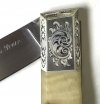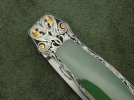Matthew Evans
Elite Cafe Member
- Joined
- Jul 8, 2017
- Messages
- 410
Good afternoon and I hope everyone is doing well. I was hoping someone out there has had experience with beadblasting steel as preparation for engraving a firearm. At the moment I have stoned and hand sanded my Kimber gold match stainless 2 to a reflective finish with no scrape marks and the shape that I want and would like to take my time getting the right texture before a graver touches it. (An engraving is only as good as it’s weakest link)
My goal is to find the best form, whether it’s sandblasting , beadblasting, etc and then adding a French grey with things that have been discussed already. ( cold blue then phosphoric acid toilet bowl cleaner)
I would like to get a velvety, or satin finish on my Kimber project and I will not touch it with chemicals till I’ve practiced elsewhere, so don’t get scared I’ll do something rash lol. Last resort will be handing it over to Turnbull restorations as they can do no wrong from what I see.
My thoughts without said practice are that a beadblast would be sufficient to get an even texture and the chemicals would give it the porosity on the top layer that is so desired.
Side note, has anyone beadblasted gold to give a frosted look for background rather than doming or stippling?
Thank you for your time in advance,
-Matthew Evans
My goal is to find the best form, whether it’s sandblasting , beadblasting, etc and then adding a French grey with things that have been discussed already. ( cold blue then phosphoric acid toilet bowl cleaner)
I would like to get a velvety, or satin finish on my Kimber project and I will not touch it with chemicals till I’ve practiced elsewhere, so don’t get scared I’ll do something rash lol. Last resort will be handing it over to Turnbull restorations as they can do no wrong from what I see.
My thoughts without said practice are that a beadblast would be sufficient to get an even texture and the chemicals would give it the porosity on the top layer that is so desired.
Side note, has anyone beadblasted gold to give a frosted look for background rather than doming or stippling?
Thank you for your time in advance,
-Matthew Evans










